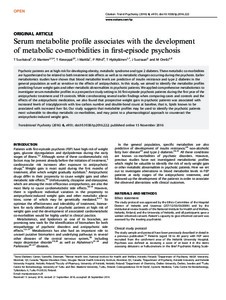Serum metabolite profile associates with the development of metabolic co-morbidities in first-episode psychosis
Suvitaival T; Mantere O; Kiesepp T; Mattila I; Poho P; Hyotylainen T; Suvisaari J; Oresic M
Serum metabolite profile associates with the development of metabolic co-morbidities in first-episode psychosis
Suvitaival T
Mantere O
Kiesepp T
Mattila I
Poho P
Hyotylainen T
Suvisaari J
Oresic M
NATURE PUBLISHING GROUP
Julkaisun pysyvä osoite on:
https://urn.fi/URN:NBN:fi-fe2021042716621
https://urn.fi/URN:NBN:fi-fe2021042716621
Tiivistelmä
Psychotic patients are at high risk for developing obesity, metabolic syndrome and type 2 diabetes. These metabolic co-morbidities are hypothesized to be related to both treatment side effects as well as to metabolic changes occurring during the psychosis. Earlier metabolomics studies have shown that blood metabolite levels are predictive of insulin resistance and type 2 diabetes in the general population as well as sensitive to the effects of antipsychotics. In this study, we aimed to identify the metabolite profiles predicting future weight gain and other metabolic abnormalities in psychotic patients. We applied comprehensive metabolomics to investigate serum metabolite profiles in a prospective study setting in 36 first-episode psychosis patients during the first year of the antipsychotic treatment and 19 controls. While corroborating several earlier findings when comparing cases and controls and the effects of the antipsychotic medication, we also found that prospective weight gain in psychotic patients was associated with increased levels of triacylglycerols with low carbon number and double-bond count at baseline, that is, lipids known to be associated with increased liver fat. Our study suggests that metabolite profiles may be used to identify the psychotic patients most vulnerable to develop metabolic co-morbidities, and may point to a pharmacological approach to counteract the antipsychotic-induced weight gain.
Kokoelmat
- Rinnakkaistallenteet [27094]
